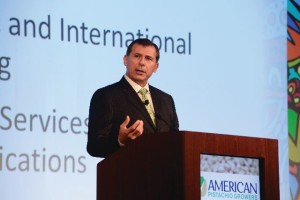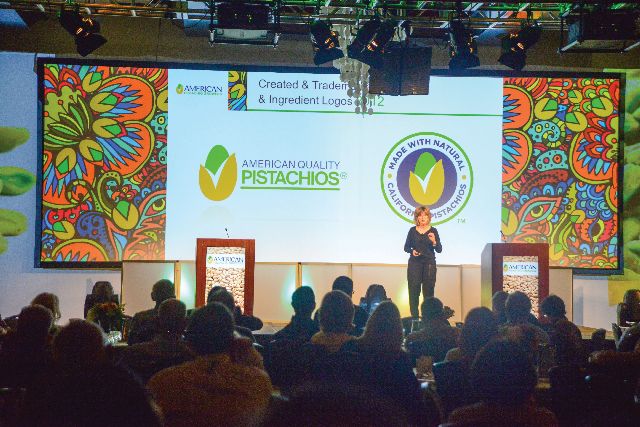Industry Update: American Pistachio Growers 2015 Conference

Richard Matoian, the executive director of American Pistachio Growers, addresses the audience at the association’s annual conference in San Diego, CA.
American Pistachio Growers (APG), an entirely entirely voluntary grower group, set another attendance record this year at its annual conference, held last month in San Diego, CA.
There were nearly 900 attendees, reports APG Executive Director Richard Matoian. “Every year, eight years in a row, we have been getting larger and larger,” he says.
With the popularity pistachios have been enjoying in recent years — industry behemoth Paramount Farms even advertised their Wonderful Pistachios product during this year’s Super Bowl — it’s hard to believe APG is less than a decade old.
Prior to 2011, it was known as the Western Pistachio Association, which itself was formed only a few years before that as growers sought marketing muscle after the California Pistachio Commission was dissolved in 2007.
The commission, which was funded by a mandatory assessment, was dissolved after Paramount, the largest tree nut grower in the world, withdrew its support. Such commissions require not only two-thirds of the growers to support it, but those growers must represent two-thirds of the crop.
Today’s APG reflects that dynamic. While with 627 members they represent nearly two-thirds of the state’s growers, those members produce slightly less than half the total crop. Still, growth in membership has been impressive, up nearly 90% since fiscal year 2008-09.
Fill ’Er Up
The organization changed its name in 2011 to enhance global marketing efforts and clearly communicate the composition of the organization to a global audience.
International markets will become increasingly important to the group’s success, though Matoian notes pistachios have become much more popular in the U.S. — annual per capita consumption has risen from 1/10 pound per person to ¼ pound over the last 20 years.
“We’re going in the right direction,” he says. “We’d certainly like to be like some other commodities such as almonds.”
While almonds have clearly been the model crop — though another tree nut, walnuts, has also enjoyed success — USDA-National Agricultural Statistical Service figures show that pistachios actually deliver growers higher returns per acre than do almonds or walnuts.

Matoian shares a laugh with APG Board members Anil Gupta and Brian Watte.
Matoian says a lot of that credit should go to the growers themselves. Yield per acre in 1980 was just over 1,000 pounds. Today it is well over 3,000 pounds per acre.
“Very simply,” he says, “growers have learned how to put a lot more product on the trees.”
Of course, it’s not like they haven’t had a fair amount of help from researchers, especially those from University of California Cooperative Extension. Pistachio growers, perhaps more so than other nut growers, have to be extraordinarily precise in their cultural practices, Matoian says.
Pistachios grow differently. Most nuts grow as one would expect, with the nut itself and the shell growing at the same rate. But in pistachios, the shell forms first, in the spring. Inside that shell is an embryo which grows to fill the shell.
Nut-fill doesn’t occur until the summer, in late June and July, when the shell is no longer growing. If you don’t have things in balance at the nut-fill stage, you won’t get a decent sized crop. Growers have to apply the proper nutrients and water at just the right time.
“You build the house first, and then you put the people inside,” Matoian says. “It is unique to pistachios.”

Judy Hirigoyen, the director of Global Marketing for American Pistachio Growers, addresses the annual conference.
Monster Crops Loom
It’s not just yields that are up, as prices have also increased. Back in the early 1980s the price was about $1.50 a pound, a dollar off today’s price of $2.50 a pound.
High prices can be something of a double-edged sword, however, especially when it comes to export markets, Matoian says. The Indian market is a good example. While the market is there — more than 1 billion people, and a burgeoning middle class — sales haven’t increased as much as pistachio marketers had hoped.
“The price point is what’s stopping us at the moment, especially when compared to almonds, the favored nut in India,” he says. “But as incomes rise and more people are exposed (to pistachios), it will come around.”
It can’t happen soon enough for growers, with huge crops clearly expected to appear in the near future. In fact, you might say the industry has 2020 vision, the year the crop is expected to top the 1 billion-pound mark.
It’s not a certainty — especially in California agriculture in this, the fourth consecutive year of drought — but the trees are in the ground. The industry only topped the 100,000-acre mark at the turn of the millennium, and today it’s more than 300,000 acres.
That may not sound like much with official almond estimates of 800,000 acres, with many people in the industry saying the actual figure is much higher, but that’s still a high rate of growth for pistachios. Especially when you consider how pistachios are the least precocious of nut or fruit crops.
The trees generally take seven years to put on a full crop, says Matoian, who notes that about one quarter of the trees in the ground are nonbearing. In 2014, there were 221,000 bearing acres and 74,000 nonbearing acres.
“The challenge is that with so many acres going into production, we need to be ready,” he says. “Our mantra is ‘Market ahead of anticipated production.’ We want to make sure we have programs and activities in place.”
The APG’s motto is “The Power of Pistachios.” It’s trying to get the message out to consumers that pistachios are not only a delicious snack, they are also extremely nutritious. So the association is focusing on fitness and beauty with a team of ambassadors that includes cyclist Mark Cavendish, snowboarder Jeremy Jones, and Miss California.
It also has what would seem to be a natural pairing with Anheuser Busch’s Michelob Ultra beer, which is low in calories and carbohydrates. When people buy a 12-pack, they can get anywhere from $2 to $6 off a bag of pistachios.
“As long as we keep promoting the product and getting consumers tuned into its health and nutritional benefits, more consumers are able to recognize that tree nuts in general are healthful,” he says. “We want to keep that momentum going. In the past there were misconceptions, people used to just think nuts were high in fat. Now people know more, and they know it’s good fat. It’s definitely helping our cause.” ●









